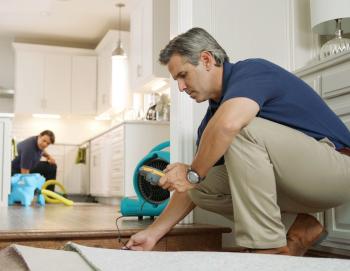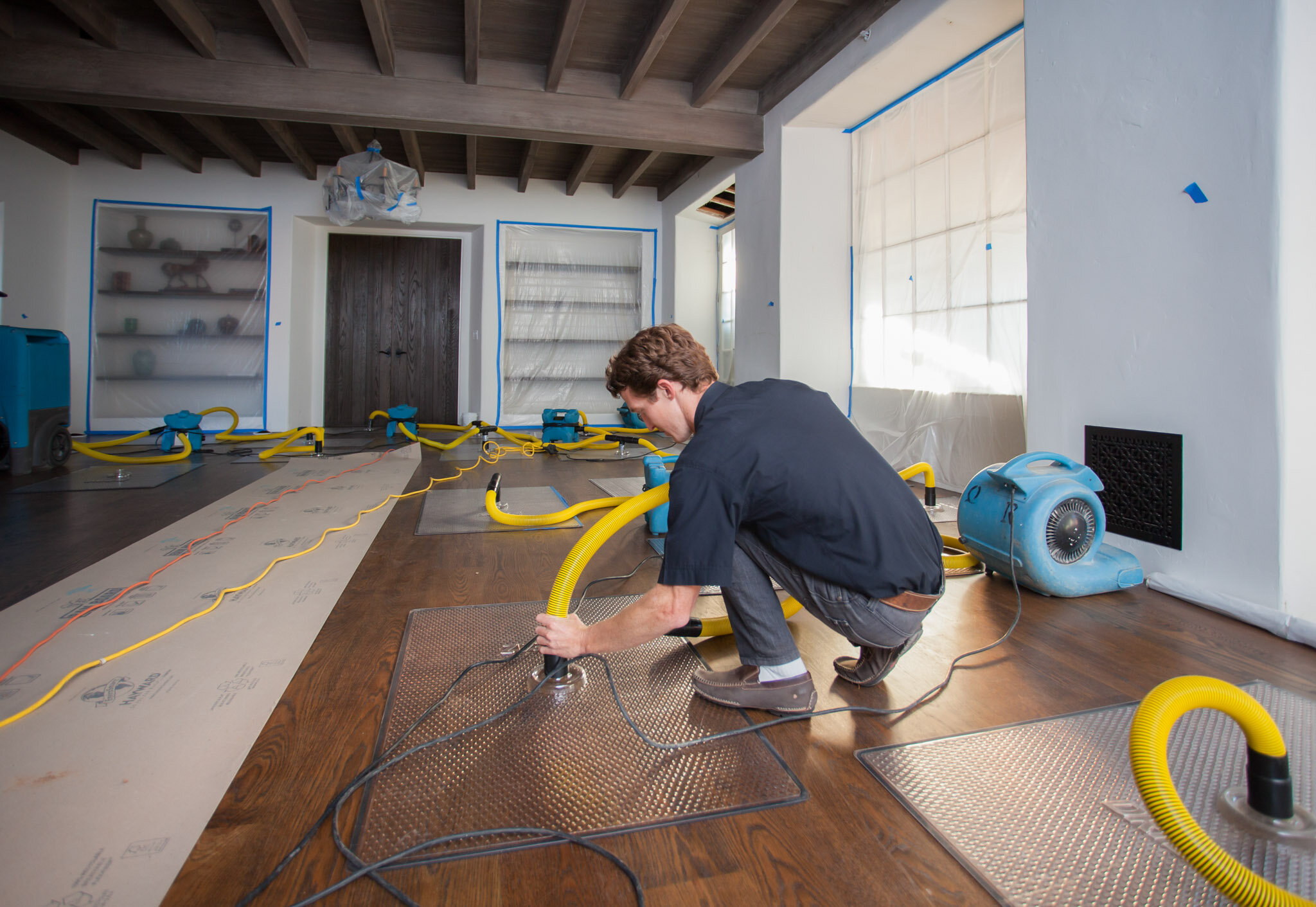Water Damage Restoration 101: Understanding the Process and Price
Water damage can strike all of a sudden, leaving homeowners in a state of complication. Understanding the repair procedure is vital for effective recuperation. From examining the damage to picking the ideal provider, each step impacts the overall result and cost. Variables such as the kind of water damage and urgency also play a significant role. What are the specific methods made use of in reconstruction, and how can one plan for prospective costs?
Sorts Of Water Damage

First Analysis and Examination

Water Extraction Techniques
Complying with the preliminary evaluation, effective water extraction strategies are used to reduce damage and stop more concerns. These techniques include using customized devices such as industrial-grade vacuums and submersible pumps - Water Damage Restoration. The choice of method depends upon the volume of water existing and the kind of materials influenced. For standing water, completely submersible pumps are commonly utilized for rapid removal, while vacuum cleaners are ideal for drawing out water from carpetings and upholstery. Furthermore, progressed techniques like water extraction floor coverings may be employed for hard-to-reach areas - Flood Cleanup Services. The objective is to eliminate as much water as feasible, minimizing the potential for mold growth and architectural damage. Motivate and effective water removal is necessary in the total water damage remediation process
Drying and Dehumidification Process
Once the water removal is full, the drying and dehumidification process becomes essential to recovering the afflicted location. This stage normally uses industrial-grade dehumidifiers and air movers to properly decrease dampness levels. The dehumidifiers attract damp air, eliminating excess moisture, while air movers flow air to speed up evaporation. Tracking tools is typically made use of to track moisture and temperature levels, guaranteeing optimal drying out conditions. The duration of this process can vary relying on the degree of the water damage and environmental aspects. It is necessary to completely completely dry all affected materials, including wall surfaces, floor covering, and furnishings, to stop mold growth and structural damage. Correct execution of this step is vital for an effective reconstruction end result.
Cleansing and Sterilizing Damaged Locations
As soon as the drying out process is full, a comprehensive preliminary evaluation and examination of influenced areas is crucial to recognize contamination levels. Reliable cleaning methods and proper products have to then be employed to eliminate particles and stains. Ultimately, sanitization and disinfection techniques are important to ensure that dangerous pathogens are eliminated, restoring the room to a secure condition
First Analysis and Examination
Prior to starting any kind of reconstruction initiatives, a comprehensive initial evaluation and evaluation of the influenced areas are important for reliable cleaning and disinfecting. This process involves recognizing the extent of water damage, establishing the resource of the water invasion, and assessing the materials influenced. Examiners generally try to find signs of mold and mildew development, structural honesty problems, and harmed personal belongings. The assessment also includes inspecting wetness degrees using customized tools to ensure no hidden water pockets remain, as these can result in additional complications. Recording the findings is essential for intending the next steps in the repair process. An in-depth preliminary analysis enables repair experts to design a targeted strategy for reliable cleansing and sterilizing, ultimately decreasing damage and health dangers.
Cleaning Methods and Products
Reliable cleansing and disinfecting of water-damaged areas need a variety of strategies and products customized to the particular products impacted. For permeable surfaces like drywall and carpeting, extraction approaches are necessary to remove excess dampness, followed by deep cleansing with specialized cleaning agents. Non-porous materials such as ceramic tile or metal can be cleaned up using commercial-grade cleaners that properly remove impurities. Steam cleaning is another efficient strategy, particularly for rugs and furniture, as it makes use of heats to eliminate germs and mold (Flood Cleanup Services). In addition, environment-friendly products are significantly preferred for their safety and efficiency - Water Damage Restoration. Ultimately, selecting the proper cleaning methods and items not only guarantees prompt sanitation yet additionally aids in protecting against more damage and wellness risks related to water invasion
Sanitization and Disinfection Methods
When dealing with water damage, appropriate sanitization and sanitation methods are necessary to ensure the safety and security and health of the afflicted environment. After first cleaning, surface areas should be treated with appropriate anti-bacterials to get rid of microorganisms, mold, and bacteria that flourish in wet conditions. Common methods include using EPA-approved chemical anti-bacterials, which can be used with spraying or cleaning methods. Additionally, ultraviolet (UV) light systems can effectively disinfect areas by reducing the effects of bacteria without rough chemicals. The option of approach often relies on the type of products affected and the level of contamination. Ultimately, extensive sanitization not just recovers a safe home but also aids protect against future health threats related to lingering moisture and mold growth.

Repair Work and Restoration Options
Evaluating the damage caused by water direct exposure is vital for identifying the ideal fixings and reconstruction options. Homeowners might deal with different problems, consisting of harmed drywall, deformed flooring, and compromised architectural elements. Relying on the extent of the damage, repair services may involve changing areas of drywall, installing new floor covering, or reinforcing architectural beams. In situations of severe damage, complete substitute of afflicted products may be needed. Additionally, expert conservators frequently advise utilizing dampness meters to examine hidden dampness levels prior to picking the best course of action. It is very important to act promptly to stop mold growth and additional damage. Selecting the right alternatives not just brings back the residential or commercial property but additionally assures lasting safety and functionality.
Aspects Affecting Restoration Costs

The extent of water damage straight affects the repair sets you back home owners can expect to sustain. Variables such as the resource of the water, the period of direct exposure, and the damaged materials greatly affect prices. For instance, tidy water damage from a busted pipe is normally less costly to bring back contrasted to damage brought on by sewer. In addition, the degree of contamination determines the need for specialized cleansing and disposal services, better enhancing expenditures. Geographic area also contributes, as regional labor rates and availability of remediation solutions can differ. The seriousness of the reaction influences costs; quicker interventions usually lead to reduce overall costs by stopping more damage. Recognizing these elements is crucial for property owners when approximating restoration prices.
The 3 key types of water damage are classified based on contamination degrees: clean water, grey water, and black water. A detailed preliminary evaluation and evaluation are essential steps in the water damage remediation procedure. For standing water, submersible pumps are commonly made use of for fast elimination, while vacuums are excellent for removing water from rugs and upholstery. The degree of water damage straight influences the restoration sets click here for more info you back home owners can expect to sustain. Tidy water damage from a damaged pipeline is generally less expensive to restore compared to damage triggered by sewer.